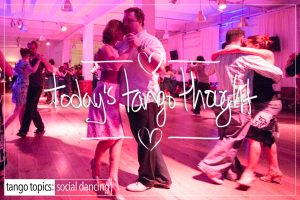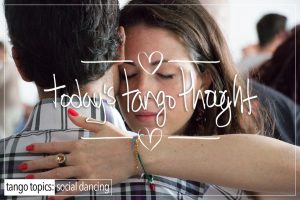At some point along your tango curve, you have wanted 1.) to practice a step, a pattern, or a figure. Or 2.) you have seen something that you want to try out. Or 3.) you’re imagining an idea of how something might work and want to try it. In all three of these instances, you will need a practice partner. You’ll need to schedule their time against yours. And once you’re in the same room with them, balance their issues of how they do X vs. how you engage X. And once that challenge is overcome then it’s getting into the idea of what it is you had in mind to begin with. All told, this could be several hours or days between the idea and the actual doing of it.
Sometimes that’s not enough, you need something immediately. You need to play with this stuff now. So as a result some folks will go to the next available practica, and/or class, or their local private lesson and try this stuff out, sometimes with very mixed results.
Some people go the route of actually getting that private practice time, and then videoing themselves immediately. The immediate part is insanely important. They don’t want to talk about it. They just want to see it work without talking about it. They want to see what happens and then play that response back several times without necessarily talking about it or discussing it. This is known as ‘playing with the blank response’. Blank response ? If you lead/follow something the right way, there should be a specific response, but if it’s not done the right way, they’ll respond with their training or technique. And that response is golden actually. It provides useful information in how we lead and follow something and why something happens. That’s a blank response. At the same time, later on, we want to figure out the what the possibilities are. What MAY happen. And some people video this too. They want the unvarnished responses, the one where you haven’t processed it, and practiced it. But rather just to see if both parties get hear the same things.
These processes are really great when there’s an available partner.
But what happens in the case of not having an available partner ?
That’s where we talk about Tango Sticks.
For years, when a Lead has wanted to try something out, or a Follower who has been paying attention in what they’re being led to, and there is no available partner (with no onboard ‘issues’) available one used a pair of broomsticks to substitute the dancing partner so that they could ‘practice’ these issues or map something out.
Some people have even gone the route of performing with the sticks and showing what you can do with them. And some folks use this process as teaching tool, and exercise tool for mapping things out.
There are some major minuses to this work and there are some major pluses.
The minus is that a thinking, breathing, human being will respond with their foibles, issues, and technique. The pluses to this ? A thinking, breathing, human being will respond with their foibles, issues, and technique. It’s a lose-lose, or win-win situation depending on your point of view.
Mapping something out is never a bad idea. It reinforces your own thinking about how something MIGHT be accomplished. It may not answer the question entirely until you have a live person in front of you, but it does allow you to work out all the gross details of a particular idea. So here’s a good idea, get yourself a pair of cheap broomsticks and start playing! And just in case you want an updated broom, Tango Topics suggests the venerable ‘Walking Stick‘, which does the same job, it’s generally made out of aluminum instead of wood.










